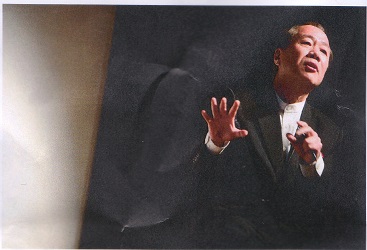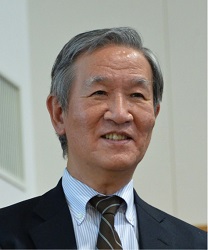Keynote
Kun-pyo LEE(Department of Industrial Design, KAIST)

- Title
Research, Education, and Practice for Design 3.0 - Abstract
Historically, Design as a discipline has gone through big paradigm shifts where research, education, and practice greatly differ from each other. In recent years, the macro environment surrounding Design has rapidly changed and various emerging trends are strongly implying that a Design 3.0 as a new paradigm is on the rise. The speech explores what those trends are, as well as what new research, education, and practice will be like for this new paradigm. First, a foundational model of the discipline is introduced, and the mutual relationships between research, education, and practice are described. Secondly, based on the disciplinary model, historic patterns of developments in Design paradigms are identified and compared as Design 0.0, 1.0, and 2.0. Moreover, characteristics and examples of research, education, and practice in design 0.0 (Craft), 1.0 (Design by Drawing), and 2.0 (User-centered Design) are also exemplified. A comparison of Design paradigms will be followed by listing up some emerging trends, which will be used for speculating research, education, and practice of Design 3.0. Finally some attempts for novel research, education, and practice in the department of Industrial Design at KAIST are introduced with some examples and discussed regarding their validity. The author hopes that the speech may provoke critical thought on what new research, education, and practice in this rapidly changing new design paradigm will be like. - Profile
Kun-Pyo Lee is the professor and head at Department of Industrial Design, KAIST, Korea and he also worked as the head of the corporate design center and executive vice president at LG Electronics in Seoul, Korea for last two and half years. He is also directing Human-Centered Interaction Design Lab. He graduated from Joong Ang university (BFA), Institute of Design, Illinois Institute of Technology (MS. Design), and University of Tsukuba (Ph.D. Design) respectively. He has worked in the field of design methodology, design planning, user-centered design, user interface design, user-experience design and, most recently, crowd source design. He is serving as president for IASDR (International Association of Societies of Design Research) In addition to teaching and conducting research, Dr. Lee has worked on research projects with many of the world’s leading companies and organizations such as LG Electronics, Samsung Electronics, Johnson and Johnson, Volkswagen, and various governmental organizations. He has served on advisory boards of several organizations and journals in Korea and abroad, and has worked for various professional design organizations such as the International Association of Societies of Design Research (president), Design Research Society (Fellow & council member), Korea Society of Design Science (president), Korea Society of Emotion and Sensitivity (president), and Korea Society of Ergonomics (vice president). He has published widely (over 350 articles, papers, books, and book chapters) both in Korea and abroad, has served on international juries, and has been an invited keynote speaker and lecturer at over 150 conferences and institutions throughout the world. Among many awards he has won are Grand Prize in the Japan Design Foundation’s Osaka International Design Competition, best research in the Journal of Japanese Society of Kansei Engineering, best paper in the 2nd Asia Design Conference, best paper 2004 at the HCI conference, best paper in KSES conference, Grand Achievement awards, KSDS, best lecturer award, KAIST, and designer of the year by Monthly Design magazine (Korea).
Ken Tomiyama(Chiba Institute of Technology)

- Title
Virtual Kansei as Robot Kansei - Abstract
Can a robot have Kansei? What is Kansei for a robot? What good does robot Kansei have? How do we construct robot Kansei? This talk gives my answers to those questions. First, robots are machines. We define robots as clever, convenient tools, no more no less. As such, robots cannot have Kansei, which is unique to humans. Then, how can robots have Kansei? Our answer is virtual Kansei. Consider the emotion first. It is the emotion that humans perceive in a robot, which is induced by robot behavior. A robot is not really angry, but the human feels that the robot is angry. The ability of a robot that makes humans perceive a particular emotion in the robot is defined as the virtual emotion. In order to construct a system that generates virtual emotion, we closely observed human emotion and decided to construct three modules: emotion detector, emotion engine, and emotion expressive modulator. The emotion detector detects the emotion time-series of the partner human from their facial expression, voice sound and body motion. The emotion engine generates the internal virtual emotion of a robot using such methods as NN, Petri-net, HMM and so on. Finally, the emotion expressive modulator modulates robot motions in such a way that the robot expresses chosen emotions. Our recent study focuses on virtual Kansei, where we try to identify physical features that makes motions Kawaii and, eventually, let our robot to both express and understand Kawaii-ness in motion. - Personal History
Dr. Tomiyama graduated from Tokyo Institute of Technology in 1971with B.Eng., and obtained M.S. and Ph.D. degrees in System Science at the University of California, Los Angeles (UCLA) in 1973 and 77, respectively. He worked at the University of Texas at El Paso (UTEP) 1977-81 and at Pennsylvania State University (PSU) 1981-88 as Assistant Professor. He received C. R. Nichols Teaching Excellence Award in 1981 at UTEP. He was chosen twice as a Summer Faculty Research Fellow by the US Air Force Office of Scientific Research and spent summer months at Air Force Geophysics Laboratory, Hanscom Air Force Base, MA in 1984 and at Air Force Wright Aeronautical Laboratory, Wright Patterson Air Force Base, OH in 1986. He was one of the core members to create the Central Pennsylvania Japanese School in 1984 and was a member of the Board of Directors, 1984-88. He joined the Department of Mechanical Engineering, Aoyama Gakuin University in Tokyo in 1988 first as Assistant Professor and promoted to Professor in 1991. He was chairman of the department, 1995-97. He was also jointly appointed as Researcher at Aoyama Gakuin University Research Institute, 1989-94. He was involved in creating a consortium of three academic departments in 2000, including the Department of Integrated Information Technology where he was the inaugurating chairman. In 2006, he moved to Chiba Institute of Technology to create the Department of Advanced Robotics with a novel curriculum, which served as a model at other institutions. He became a member of Future Robotics Technology Center (fuRo) in 2014. He is interested in system science, robotics, Kansei engineering, teaching and California wine. He authored and co-authored more than 150 publications. His recent works include development of robotics education materials and literature for young generation. He is a member of JSKE, IEEE, RSJ, SICE, ASME, etc.
